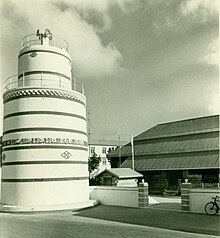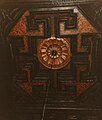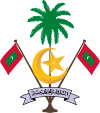Islam in the Maldives
| Islam by country |
|---|
 |
|
|
Islam is the state religion of the Maldives. The 2008 constitution "Fehi Ganoon" clearly states the significance of the Islamic Law in the country. The constitution requires that citizenship status be based on adherence to the state religion.
History[]


- The importance of the Arabs as traders in the Indian Ocean by the 12th century may partly explain why the last Buddhist king of Maldives Dhovemi converted to Islam in the year 1153[1] (or 1193, for certain copper plate grants give a later date[citation needed]). The king thereupon adopted the Muslim title and name (in Arabic) of Sultan (besides the old Dhivehi title of Maha Radun or Ras Kilege or Rasgefānu[citation needed]) Muhammad al-Adil, initiating a series of six Islamic dynasties consisting of eighty-four sultans and sultanas that lasted until 1932 when the sultanate became elective.[1] The formal title of the Sultan up to 1965 was, Sultan of Land and Sea, Lord of the twelve-thousand islands and Sultan of the Maldives which came with the style Highness.[citation needed] The person traditionally deemed responsible for this conversion was a Sunni Muslim visitor named Abu al-Barakat Yusuf al-Barbari.[1] His venerated tomb now stands on the grounds of Medhu Ziyaaraiy, opposite[citation needed] the Hukuru Mosque in the capital Malé.[1] Built in 1656, this is the oldest mosque in Maldives.[1] Following the Islamic concept that before Islam there was the time of Jahiliya (ignorance), in the history books used by Maldivians the introduction of Islam at the end of the 12th century is considered the cornerstone of the country's history.[original research?]
Compared to the other areas of South Asia, the conversion of the Maldives to Islam happened relatively late. Arab Traders had converted populations in the Malabar Coast since the 7th century, and the Muslim General Muhammad Bin Qāsim had converted of Sindh and Southern Punjab to Islam at about the same time. The Maldives remained a Buddhist kingdom for another five hundred years (perhaps the south-westernmost Buddhist country) until the conversion to Islam.[citation needed]
Introduction of Islam[]
Maghrebi/Berber Theory

Amazigh interest in Maldives also was reflected in the residence there in the 1340s of Ibn Battutah.[1] The well-known Moroccan traveller wrote how a Berber from North Morocco, one Abu Barakat Yusuf the Berber, was believed to have been responsible for spreading Islam in the islands, reportedly convincing the local king after having subdued Ranna Maari, a demon coming from the sea.[2] Even though this report has been contested in later sources, it does explain some crucial aspects of Maldivian culture. For instance, historically Arabic has been the prime language of administration there, instead of the Persian and Urdu languages used in the nearby Muslim states. Another link to North Africa was the Maliki school of jurisprudence, used throughout most of North Africa, which was the official one in the Maldives until the 17th century.[3]
Somali Theory[]
Some scholars have suggested the possibility of Ibn Battuta misreading Maldive texts, and having a bias or felt partial towards the North African Maghrebi/Berber narrative of this Shaykh. Instead of the East African origins account that was known as well at the time.[4] Even when Ibn Battuta visited the islands of the Maldives, the governor of the island at that time was Abd Aziz Al Mogadishawi, a Somali.[5]
Also another prominent Shaykh on the Island during Ibn Battuta's stay, was Shaykh Najib al Habashi Al Salih, another learned man from the Horn of Africa. His presence Indicating a strong Horn of African Islamic presence on the Island.[6]
Scholars have spoken that Abu al-Barakat Yusuf al-Barbari might have been a resident of Berbera, a significant trading port on the north western coast of Somalia.[7] Barbara or Barbaroi (Berbers), as the ancestors of the Somalis were referred to by medieval Arab and ancient Greek geographers, respectively.[8][9][10] This is also seen when Ibn Battuta visited Mogadishu, he mentions that the Sultan at that time 'Abu Bakr ibn Shaikh Omar', was a Berber (Somali).
According to scholars, Abu al-Barakat Yusuf al-Barbari was Yusuf bin Ahmad al-Kawneyn, a famous native Somali scholar.[11] In Arabic, Abu Barakat, is a direct translation of the Somali Aw Barkhadle, which means "Blessed Father", one of the Shaykh's well known nicknames. Yusuf bin Ahmad al-Kawneyn is known for establishing the Walashma dynasty of the Horn of Africa.[12] This famous Shaykh was born in the city of Zeila, a Somali city well known for its history, and also for its spreading of the Islamic faith throughout Africa and Asia. in Zeila, the oldest mosque in Africa is found, Masjid al-Qiblatayn (Somalia), built during the time of the Prophet Muhammad. After the Shaykh's conversion of the population of Dogor (now known as Aw Barkhadle, named after him), a town in Somalia. He is also credited to have been responsible for spreading Islam in the Maldivian islands, establishing the Hukuru Miskiy, and converting the Maldivian population into Islam.[13][14] Ibn Battuta states the Maldivian king was converted by Abu al-Barakat Yusuf al-Barbari (Blessed Father of Somalia).[15]
Persian Theory[]
Another interpretation, in the Raadavalhi and Taarikh,[16][17] is that Abu al-Barakat Yusuf al-Barbari was an Iranian from Tabriz called Yusuf Shamsud-din, also locally known as Tabrīzugefānu. In the Arabic script the words al-Barbari and al-Tabrizi are very much alike, owing to the fact that at the time, Arabic had several consonants that looked identical and could only be differentiated by overall context (this has since changed by addition of dots above or below letters to clarify pronunciation – For example, the letter "B" in modern Arabic has a dot below, whereas the letter "T" looks identical except there are two dots above it). The first reference to an Iranian origin dates to an 18th-century Persian text.[18]
Sufi tradition[]
The Maldives has had a long history of Sufic orders, as can be seen in the history of the country such as the building of tombs.[citation needed] They were used until as recently as the 1980s for seeking the help of buried saints.[citation needed] They can be seen today next to some old mosques and are considered today as cultural heritage.[citation needed]
Other aspects of tassawuf, such as ritualized dhikr ceremonies called Maulūdu (Mawlid) — the liturgy of which included recitations and certain supplications in a melodic tone—existed until very recent times.[citation needed] These Maulūdu festivals were held in ornate tents specially built for the occasion.[citation needed] At present Islam is the official religion of the entire population, as adherence to it is required for citizenship.[citation needed]
Islamic influence[]
Islam is the state religion of Maldives, and adherence to it is legally required for citizens by a revision of the constitution in 2008: Article 9, Section D and 10 states,
A non-Muslim may not become a citizen of the Maldives.[19]
The religion of the State of the Maldives is Islam. Islam shall be the one of the basis of all the laws of the Maldives. No law contrary to any tenet of Islam shall be enacted in the Maldives.[20]
The traditional Islamic law code of shariah forms the Maldives' basic code of law, as interpreted to conform to local Maldivian conditions by the President, the attorney general, the Ministry of Home Affairs, and the Majlis.[1] Article 142 of the constitution states,
When deciding matters on which the Constitution or the law is silent, Judges must consider Islamic Shari’ah.[20]
Proselytizing by non-Muslims in Maldives, including the possession and distribution of non-Muslim religious materials (such as the Bible), is illegal. Public worship by adherents of religions other than Islam is forbidden.[citation needed]
On the inhabited islands, the miski, or mosque, forms the central place where Islam is practiced.[1] Because Friday is the most important day for Muslims to attend mosque, shops and offices in towns and villages close around 11 a.m., and the sermon begins by 12:30 p.m.[1]
Adhan (prayer) sessions are held five times daily. Mudhimu, the mosque caretakers, make the call.[1] Most shops and offices close for fifteen minutes after each call.[1] During the ninth Muslim month of Ramadan, cafés and restaurants are closed during the day, and working hours are limited.[1]
Mosques[]
Most inhabited Maldivian islands have several mosques; Malé has more than thirty.[1] Most traditional mosques are whitewashed buildings constructed of coral stone with corrugated iron or thatched roofs.[1]

Dadimagi miskit in Fuvahmulah, 1981

Kede-ere miskit in Fuvahmulah, 1981

Gen Miskit, Fuvahmulah, 1984

Dharavandhoo Friday Mosque

Bandos island mosque, North Male Atholl
Some Maldivian mosques host mandala-like decorative elements, cultural influences from the pre-Islamic period and/or from the Indian sub-continent.[citation needed]

A mandala on the ceiling of Darumavanta Rasgefaanu mosque, Malè. Lacquered wood carving. The damaged Mandala was covered with a simple geometrical drawing painted on plywood.
Photograph of a mandala on the ceiling. Lacquered wood carving; quite damaged. Kalhuhuraage mosque, Malè, Maldives, 1987
Photograph of a mandala carving on wooden door panel. Fua Mulaku Island, 1986

Photograph of a mandala on the ceiling. Lacquered wood carving. 'Idu mosque, Malè, 1989
In Malé, the Islamic Center and the Grand Friday Mosque, built in 1984 with funding from the Persian Gulf states, Pakistan, Brunei, and Malaysia, are imposing, elegant structures.[1] The gold-colored dome of this mosque is the first structure sighted when approaching Malé.[1] In mid-1991 Maldives had a total of 724 mosques and 266 women's mosques.[1]

Old Mosque of Malé, white coral decorations

Sample of decorative Arabic writing on lacquered wooden panel. Idu Miskit, Malé

Filitheyo graveyard
Radicalism[]
The Guardian estimates that 50-100 fighters have joined ISIS and al Qaeda from the Maldives.[21] The Financial Times puts the number at 200.[22]
- 2007 Malé bombing: On 29 September 2007 a homemade bomb went off in Sultan Park near the Islamic Centre in the Maldivian capital Malé, injuring 12 foreign tourists. In December, three men were sentenced to 15 years in jail after they confessed to the bombing. Two of those imprisoned, and Ahmed Amin - both Maldivian natives in their early twenties-had their sentences changed from incarceration to three-year suspended sentences under observation and were later set free in August 2010.[23]
- 2011 Ismail Khilath Rasheed controversy
- In February 2012 almost all the Maldives National Museum's pre-Islamic artifacts, dating back to before the 12th century, were destroyed during an attack: "Some of the pieces can be put together but mostly they are made of sandstone, coral and limestone, and they are reduced to powder." He said the museum had "nothing [left] to show" of the country's pre-Islamic history.[24][25] Among the damaged objects were a six-faced coral statue, an 18 in (46 cm) high bust of Buddha, as well as assorted limestone and coral statues[26]
Religious Stand of Maldives and Public Etiquette[]
In 2008 after the ratification of the new constitution, multi party democracy was instated in the Maldives. Maldivian Religious Party Adhaalath was founded by the religious scholars and religious activists. Under the new freedom of speech and relaxed laws radicalism and different forms of religious factions rose in Maldives.
The Religious extremism was controlled by the state, since in every Presidency the coalition governments consisted Adhaalath Party's affiliation. The Islamic Ministry and major executive portfolio is represented by the Adaalath Party. In Maldives, general clothing guidelines are observed as per democratic law instated and extremism is punishable by lengthy jail sentences.
See also[]
- Freedom of religion in the Maldives
- Islam in South Asia
References[]
- ^ Jump up to: a b c d e f g h i j k l m n o p q Ryavec, Karl E. (1995). "Maldives: Religion". In Metz, Helen Chapin (ed.). Indian Ocean: five island countries (3rd ed.). Washington, D.C.: Federal Research Division, Library of Congress. pp. 267–269. ISBN 0-8444-0857-3. OCLC 32508646.
 This article incorporates text from this source, which is in the public domain.CS1 maint: postscript (link)
This article incorporates text from this source, which is in the public domain.CS1 maint: postscript (link)
- ^ Ibn Battuta, Travels in Asia and Africa 1325-1354, tr. and ed. H. A. R. Gibb (London: Broadway House, 1929)
- ^ The Adventures of Ibn Battuta: A Muslim Traveller of the Fourteenth Century
- ^ Honchell, Stephanie (2018), Sufis, Sea Monsters, and Miraculous Circumcisions: Comparative Conversion Narratives and Popular Memories of Islamization, Fairleigh Dickinson University and the University of Cape Town, p. 5,
In reference to Ibn Battuta's Moroccan theory of this figure, citation 8 of this text mentions, that other accounts identify Abu al-Barakat Yusuf al-Barbari as East African or Persian. But as fellow Maghribi, Ibn Battuta likely felt partial to the Moroccan version.
- ^ Defremery, C. (December 1999). Ibn Battuta in the Maldives and Ceylon. Asian Educational Services. ISBN 9788120612198.
- ^ Takahito, Mikasa no Miya (1988). Cultural and Economic Relations Between East and West: Sea Routes. Otto Harrassowitz Verlag. ISBN 9783447026987.
- ^ "Richard Bulliet – History of the World to 1500 CE (Session 22) – Tropical Africa and Asia". Youtube.com. 23 November 2010. Retrieved 23 September 2013.
- ^ F. R. C. Bagley et al., The Last Great Muslim Empires (Brill: 1997), p. 174.
- ^ Mohamed Diriye Abdullahi, Culture and Customs of Somalia, (Greenwood Press: 2001), p. 13.
- ^ James Hastings, Encyclopedia of Religion and Ethics Part 12: V. 12 (Kessinger Publishing, LLC: 2003), p. 490.
- ^ Somalia; Wasaaradda Warfaafinta iyo Hanuuninta Dadweynaha (1972). The Writing of the Somali Language: A Great Landmark in Our Revolutionary History. Ministry of Information and National Guidance. p. 10.
Aw Barkhadle, he was a native, who lived in about 1,000 years ago and is buried now in a ruined town named after him, Aw Barkhadle, which is a few miles away from Hargeisa.
- ^ Nehemia Levtzion; Randall Pouwels (Mar 31, 2000). The History of Islam in Africa. Ohio University Press. p. 242.
Aw Barkhadle, is the founder and ancestor of the Walashma dynasty
- ^ Mackintosh-Smith, Tim (2010). Landfalls: On the Edge of Islam from Zanzibar to the Alhambra. Hodder & Stoughton. p. 384.
- ^ Galaal, Musa (1980). "Les liens historiques entre la corne de l'Afrique et les îles du golfe Persique et de l'océan Indien par les voies de l'Islam". Relations historiques à travers l'océan Indien. Belgique: l'Organisation des Nations Unies pour l'éducation, la science et la culture. p. 28. ISBN 92-3-201740-7.
Translated from French to English: Now this holy man - this is the new point (Al Kownayn) - seems to be the same as that which the people of the Maldive Islands, near India, called Barakath Al-Barbari who spread Islam in this region as he did in the Horn of Africa. We only know in which of these two regions he lived first and this prompted him to change sectors of business.The tomb of Sheik Barkhadle (Yusuf Al Kownayn) is in a ruined city called Dhogor, near Hargeisa, in the north of the Democratic Republic of Somalia.
- ^ Ibn Battuta (1968). Monteil, Vincent (ed.). Voyages d'Ibn Battuta:Textes et documents retrouves (in Arabic). Anthropos. p. 127.
- ^ Kamala Visweswaran (6 May 2011). Perspectives on Modern South Asia: A Reader in Culture, History, and Representation. John Wiley & Sons. pp. 164–. ISBN 978-1-4051-0062-5.
- ^ Ishtiaq Ahmed (2002). Ingvar Svanberg; David Westerlund (eds.). Islam Outside the Arab World. p. 250. ISBN 9780253022608.
- ^ Paul, Ludwig (2003). Persian Origins--: Early Judaeo-Persian and the Emergence of New Persian : Collected Papers of the Symposium, Göttingen 1999. Otto Harrassowitz Verlag. p. 31. ISBN 978-3-447-04731-9.
- ^ Ran Hirschl (2010). Constitutional Theocracy. Harvard University Press. p. 34. ISBN 9780674059375.
- ^ Jump up to: a b "The Constitution of Maldives". Attorney General's office, Maldives.
- ^ Jason Burke (February 26, 2015). "Paradise jihadis: Maldives sees surge in young Muslims leaving for Syria". Guardian.
- ^ Victor Mallet (December 4, 2015). "The Maldives: Islamic Republic, Tropical Autocracy". Financial Times.
- ^
Anupam Dasgupta (2011-01-23). "A Male-volent link". The Week. Archived from the original on 2011-01-24.
It surprised India when Nasheed freed two prime accused in the 2007 Sultan Park bombings in Male in August 2010. We are planning to send Mohamed Sobah and Ahmed Naseer [the two accused] back to jail. We feel they are dangerous to our society and we are not willing to risk internal security, said Ahmed Muneer, deputy commissioner of the Maldives police.
- ^ Trouble in paradise: Maldives and Islamic extremism
- ^ "Maldives museum reopens minus smashed Hindu images"[permanent dead link], Associated Press, 14 February 2012
- ^ Bajaj, Vikas (13 February 2012). "Vandalism at Maldives Museum Stirs Fears of Extremism". The New York Times.
- Islam in the Maldives
- Islam by country













